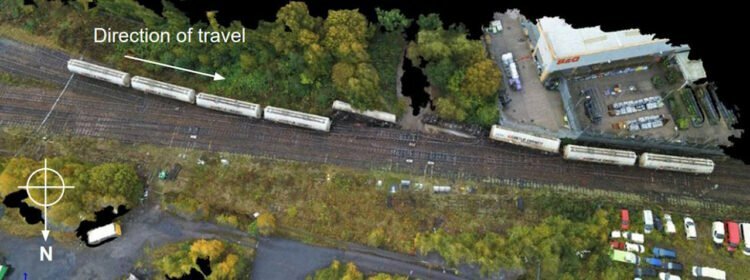The Rail Accident Investigation Branch (RAIB) has issued its report into a derailment at Petteril Bridge Junction, Carlisle last year, that caused a seven-week closure of the lines between Carlisle and Newcastle-upon-Tyne and Carlisle and Settle.
The derailment occurred at 19:53 on Wednesday, 19 October 2022, when five tank wagons in a freight train carrying cement powder from Clitheroe in Lancashire, to Mossend near Glasgow, derailed near Petteril Bridge Junction in Carlisle, and caused damage to a number of the wagons. Fortunately, no one was injured in the incident.

As well as damage to the wagons, there was significant damage to both the track and the bridge over the River Petteril.
The cause of the derailment was that one set of wheels on the ninth wagon in the train had stopped rotating up to 55 miles (88 km) before the derailment.
However, the wheels had continued to slide along the railhead, which resulted in considerable damage to the profile of the wheel treads.
The altered profile of the wheel treads meant that the wheels could not negotiate a set of points just before Petteril Bridge Junction safely, resulting in damage to the points and causing the ninth wagon to derail, which was ruptured and landed upside down in the river, although there was very little spillage of the cement powder.
In addition, because of the damaged track, five wagons became derailed, and two of these fell off the side of the bridge where the line crosses the River Petteril.
The cause of the initial wheel slide was probably due to low adhesion conditions that are normal on the route at that time of year.
When a normal brake application is made in low adhesion conditions, a wheel slide may result and will continue if the adhesion between the wheels and the rails is insufficient for the wheels to restart rotation.
There was no reason to stop the train before it reached Petteril Bridge Junction and derailed as the non-rotating wheels had not been spotted by any of the signallers on the route, by the train driver, or by any engineered system.
In their report, the Rail Accident Investigation Branch made one recommendation, which was that the railway industry should undertake work to understand the specific risks to freight trains in low adhesion conditions.
Two recommendations were also made to the railway industry that there should be a review of the railway Rule Book requirements for stopping and examining trains, and the requirements relating to drivers looking back along their trains.
Another learning point identified by the board was one for signallers, that reminded them of the circumstances in which they should stop trains for examination.
The Rail Safety and Standards Board (RSSB) Director of System Safety and Health, Ali Chegini said:
“We welcome publication of the RAIB investigation into the cause of the freight train derailment at Petteril Bridge Junction, Carlisle in October 2022. Improving the operational and safety performance of freight trains is a priority for RSSB and the rail industry, and we will be working together to review the implementation of RAIB's recommendations.”
Reminds us of the early days of Virgin – we think in the early days of regenerative braking – with burning smells from below when you got on. And a very rough ride to London which guards seemed reluctant to report. Some years though since it has been allowed to develop to that extent on our journeys.
BUT every now and then the morning Northern train passing below our window as we wake has an audible wheel flat, although rarely for more than a few days.